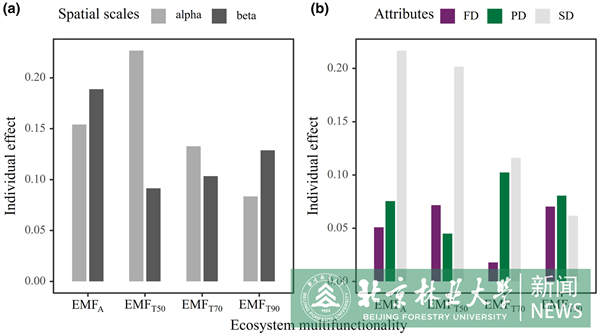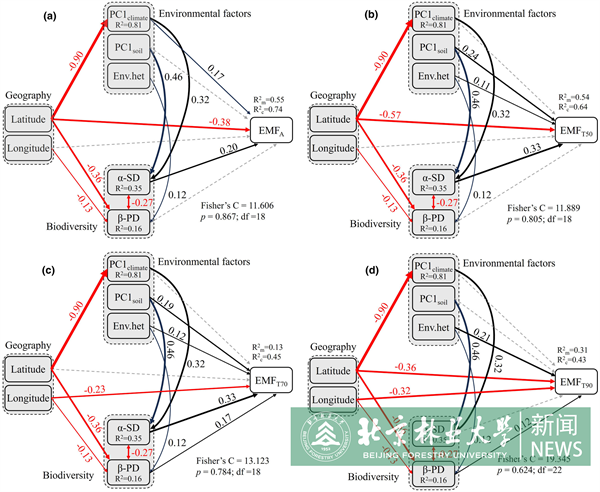Latest news
Recently, Forest Management Teachers' Group from Beijing Forestry University achieved breakthroughs in research on biodiversity and ecosystem multifunctionality. The results, presented in the paper titled "Tree diversity across multiple scales and environmental heterogeneity promote ecosystem multifunctionality in a large temperate forest region," have been published in the prestigious journal Global Ecology and Biogeography, a leading publication in the fields of Environmental Science and Ecology, with an impact factor of 6.3.

Biodiversity across different scales provides multidimensional insurance for ecosystem functioning. Although the effects of biodiversity on ecosystem multifunctionality are well recorded in local communities, they remain poorly understood across scales (from local to larger spatial scales).
This study evaluates how multiple attributes of biodiversity maintain ecosystem multifunctionality from local to regional scales, across diverse environmental gradients. The research team defines multifunctionality using both averaged and modified multiple-threshold approaches. Multiple dimensions of biodiversity across varying spatial scales were measured within the framework of Hill–Chao numbers. Using variance decomposition, linear mixed models and structural equation modelling, the team explored how multiple attributes of tree diversity at varying spatial scales affect multifunctionality, and how these relationships are modulated by environmental drivers.

It found that both α- and β-diversity are critical for regional community multifunctionality, while the relationships between species, functional and phylogenetic diversity and multifunctionality decoupled across spatial scales and thresholds of ecosystem functioning. Phylogenetic β-diversity and species α-diversity are, respectively, more important for promoting high- and moderate-threshold multifunctionality (e.g. EMFT90 and EMFT50) in regional communities. Environmental drivers typically have stronger effects than biodiversity on multifunctionality. Soil and climatic conditions had either direct effects on multifunctionality or indirect ones mediated by species α-diversity. Environmental heterogeneity is important for high-threshold multifunctionality, exerting directly and indirectly through phylogenetic β-diversity. Latitude not only directly influences multifunctionality but also modulates it through species α-diversity and phylogenetic β-diversity.

This study underscores the positive effects of biodiversity on multifunctionality across multiple dimensions. Based on the findings, the research team conclude that any design of a forested landscape that is aimed at maximizing multifunctionality should consider maintaining high local diversity as well as forest community heterogeneity at varying scales.
Li Jie, a doctoral student in the Forest Management discipline, is the first author of the paper, with Professor Zhang Chunyu of the College of Forestry as the corresponding author. The research team also includes Professor Zhao Xiuhai, Professor Cheng Yanxia, and Teacher Hao Minhui from the Forestry School, along with Professor Klaus von Gadow from the University of Göttingen, Germany.
This research was supported by the Key Project of National Key Research and Development Plan (2023YFF1304003-05) and the Program of National Natural Science Foundation of China (32371870).
Paper link: https://doi.org/10.1111/geb.13880
Written by Zhang Chunyu and Hao Minhui
Translated and edited by Song He
Reviewed by Yu Yangyang










